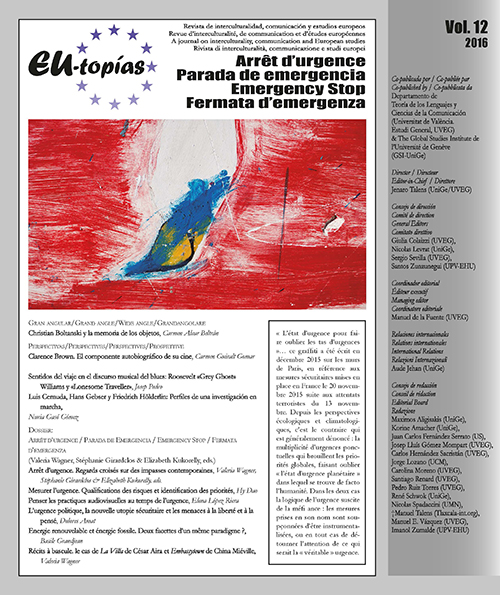Clarence Brown. The autobiographical component of his film
DOI:
https://doi.org/10.7203/eutopias.0.18638Keywords:
Clarence Brown, autobiopic, Metro-Goldwyn-Mayer, Americana genre, Ah, Wilderness! (1935), Of Human Hearts (1938), Intruder in the Dust (1949) Abstract
Abstract
This article is written with the purpose of denying the traditional approach established by the historiography towards Clarence Brown’s cinema and his image as a filmmaker. This view generally is what describes him as a commercial director who worked inside Hollywood’s studio system and made films for the stars of MGM by assignment. That is, a director without any kind of personal involvement in his films. Actually, it happens just the contrary. Both before and after entering in MGM, in 1926, his production was imbued with a great number of autobiographical features, which gives it a substantial thematic coherence. In fact, a large part of his filmography only can be understood in the light of his Southern origins and his personal life. Moreover, it was indeed in MGM where, since 1935, Brown could carry out a group of works linked to the Americana genre that were completely different, distinctive, and original. Three of them, shot on his own initiative, stand out for their highly autobiographical content: Ah, Wilderness! (1935), Of Human Hearts (1938), and Intruder in the Dust (1949). This research deals with these issues, with a special attention to the three mentioned films.
 Downloads
Downloads
 References
References
Agel, Henri (1963), Romance Américaine, París: Éditions Du Cerf.
Brion, Patrick (1979), «Clarence Brown: un grand cinéaste intimiste», Cinéma 79, 242, pp. 118-119.
Brown, Clarence (1939a), «50 Million Feet of Hollywood Romance», Picturegoer, 8 (415), pp. 6-7.
— (1939b), «Concluding 50 Million Feet of Hollywood Romance», Picturegoer, 9 (417), pp. 10-11.
Brownlow, Kevin (1968), The Parade’s Gone By..., Berkeley: University of California Press.
Crowther, Bosley (1949, 23 de noviembre), «The Screen in Review», New York Times, p. 19.
Everson, William K. (1973), «Clarence Brown: A Survey of His Work», Films in Review, 24 (10), pp. 577-589.
Eyman, Scott (1978), «Clarence Brown: Garbo and Beyond», Velvet Light Trap, 18, pp. 19-23.
«Faulkner Film Can Be True Picture Of South’s Problems» (1949, 3 de febrero), The Oxford Eagle, pp. 1, 6.
«Graftonites recall “Ah, Wilderness”» (1985, 4 de septiembre), Blackstone Valley Tribune, p. B8.
Guiralt Gomar, Carmen (2005), «El modelo clásico en cuestión: reconsideraciones sobre el cine de Clarence Brown», Archivos de la Filmoteca, 50, pp. 46-61.
— (2012), Fundamentos de la obra cinematográfica de Clarence Brown: Inicios y consolidación estilística en el contexto del cine clásico norteamericano entre los años 1915-1925, Tesis doctoral inédita, Valencia: Universidad de Valencia.
— (2012-2013), «El elemento sobrenatural en Anna Karénina (Ana Karenina, Clarence Brown, 1935)», Saitabi. Revista de la Facultat de Geografia i Història, 62-63, pp. 77-92.
— (2015), «Aportaciones historiográficas y estéticas a propósito de la co-autoría fílmica de The Last of the Mohicans (1920), de Maurice Tourneur y Clarence L.Brown», Fotocinema. Revista Científica de Cine y Fotografía, 11, pp. 50-81.
— (2016), «Self-Censorship in Hollywood during the Silent Era: A Woman of Affairs (1928) by Clarence Brown», Film History, 28 (2), pp. 81-113.
Gwin, Julia (1936), «The Inside “Low Down”», Silver Screen, 6 (7), pp. 35, 74-75.
Haun, Harry (1972, 2 de julio), «The UT Grad Who Engineered Dreams», The Nashville Tennessean Sunday Magazine, pp. 5-8.
Jacobs, Lewis (1972), La azarosa historia del cine americano, Vol. II (II Vols.), Barcelona: Lumen.
Leahy, James & Routt, William D. (1970), Rediscovering the American Cinema, Nueva York: Films Incorporated.
Lockhart, Freda Bruce (1938), «Shepherd of Stars», Film Weekly, 20 (494), pp. 6-7.
McBride, Joseph (1977), «Clarence Brown, 87, Extolled; Infer Him Bestest at Old MGM», Variety, 287, p. 19.
McGilligan, Patrick (1975-1976), «Clarence Brown: Two Children’s Movies», Focus on Film, 23, pp. 34-35, 40.
— (1993), Backstory: Conversaciones con guionistas de la Edad de Oro, Madrid: Plot.
— (2000), Backstory 2: Conversaciones con guionistas de los años cuarenta y cincuenta, Madrid: Plot.
McGilligan, Patrick & Weiner, Debra (1975-1976), «Clarence Brown at 85», Focus on Film, 23, pp. 30-33.
Neely, Jack (2008), «The Forgotten Director: Who was Clarence Brown?», Metro Pulse. Knoxville’s Weekly Voice, 18 (10), pp. 16-23.
Paris, Barry (2002), Garbo, Minneapolis: University of Minnesota Press.
Sadoul, Georges (1972), Historia del cine mundial, México: Siglo XXI.
Sarris, Andrew (1970), El cine norteamericano, Méjico: Diana.
Shaffer, George (1935, 4 de octubre), «Knoxville ’05 Gets Big Play in New Movie», Chicago Daily Tribune, p. 28.
Tavernier, Bertrand & Coursodon, Jean–Pierre (1997), 50 Años de Cine Norteamericano, Vol. I (II Vols.), Madrid: Akal.
Viviani, Christian (1980), «Inspiration et romance chez Clarence Brown», Positif, 228, pp. 22-25.
Young, Gwenda (2001), «Clarence Brown: From Knoxville to Hollywood and Back», The Journal of East Tennessee History, 73, pp. 53-73.
— (2003a), «Starmaker», Sight & Sound, 13 (4), pp. 28-30.
— (2003b), «Clarence Brown Retrospective», Londres: BFI, pp. 19-23.
— (2013), «Exploring Racial Politics, Personal History and Critical Reception: Clarence Brown’s Intruder in the Dust (1949)», Alphaville. Journal of Film and Screen Media, 6, pp. 1-18.
Downloads
Published
How to Cite
-
Abstract303
-
PDF (Español)71
Issue
Section
License
![]()
The authors conserve the copyright. All content published in EU-topías. Journal of interculturality, Communication, and European Studies are subject to the license Creative Commons Attribution-NonCommercial-ShareAlike 4.0 license. The full text of the license can be found at <http://creativecommons.org/licenses/by-nc-sa/4.0>
They may be copied, used, disseminated, transmitted and publicly displayed, provided that:
- The authorship and original source of the publication is cited (journal, publisher and URL of the work).
- They are not used for commercial purposes.
- The existence and specifications of this license of use are mentioned.
It is the responsibility of the authors to obtain the necessary permissions for images that are subject to copyright.



